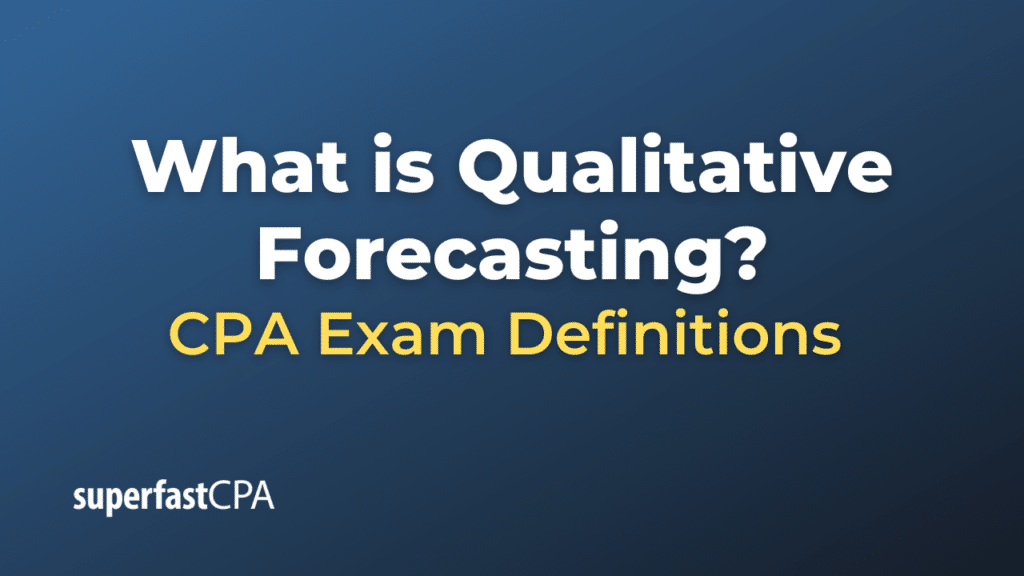Qualitative Forecasting
Qualitative forecasting involves making predictions about future events based on subjective judgment, intuition, and understanding, rather than on past statistical data. It’s especially useful when historical data is not available or when forecasting new products, events, or situations. Qualitative methods often rely on expert opinions, insights from people within the industry, and other non-quantifiable information.
Some common methods and sources of qualitative forecasting include:
- Expert Judgment: Using insights and predictions from individuals who have expertise in the area being forecasted.
- Delphi Method: A structured communication technique which relies on a panel of experts. These experts answer questionnaires in two or more rounds. After each round, a facilitator provides an anonymous summary of the experts’ forecasts and their reasons. Experts can then revise their earlier answers based on the replies of other members of their panel. This process aims to achieve a convergence of opinions.
- Focus Groups: Assembling a group of people, such as potential customers, to obtain their feedback, perceptions, and opinions on certain topics.
- Market Research: Conducting surveys and interviews to gather information about market trends, customer preferences, and other relevant factors.
- Scenario Writing: Creating detailed narratives about possible future scenarios to imagine different possibilities and their implications.
- Intuition: Sometimes, experienced decision-makers may rely on their intuition or gut feelings, especially when they have a deep understanding of the industry or situation.
- Sales Force Estimates: Salespeople provide forecasts based on their interactions and insights from current customers and prospects.
While qualitative forecasting methods are valuable in certain contexts, they come with potential limitations:
- They can be subjective, and different experts might have different opinions.
- They might be influenced by biases or emotions.
- They may not always be as accurate as quantitative methods, especially over longer time horizons.
Nevertheless, in situations where historical data is lacking or when changes in the environment make past data irrelevant, qualitative forecasting can offer invaluable insights. Often, companies use a combination of both qualitative and quantitative methods to make the most informed predictions.
Example of Qualitative Forecasting
Let’s explore a hypothetical scenario to illustrate qualitative forecasting in action:
Scenario: Imagine “EcoWear,” a startup company that plans to launch a new line of eco-friendly sportswear made from recycled plastics. Since EcoWear has no historical sales data for this product (as it’s a new launch), they can’t rely on quantitative forecasting methods alone.
Here’s how EcoWear might use qualitative forecasting:
- Expert Judgment: EcoWear consults with experts in the fashion industry and sustainability space. These experts believe that the trend towards sustainable products is growing and that there’s a market gap for eco-friendly sportswear.
- Delphi Method: The company organizes several rounds of anonymous questionnaires among a panel of experts from the fashion, recycling, and sports industries. After a few rounds, there’s a consensus that the eco-friendly sportswear market will grow by approximately 15-20% annually over the next five years.
- Focus Groups: EcoWear conducts focus groups with potential customers. These sessions reveal that there’s a strong demand for such products, especially among younger consumers who are environmentally conscious.
- Market Research: A survey sent to a broader audience shows that 65% of respondents would be willing to pay a premium for sportswear made from recycled materials.
- Scenario Writing: The marketing team at EcoWear creates potential scenarios for the next three years. One optimistic scenario sees the brand becoming a market leader in sustainable sportswear, while a more conservative scenario shows steady growth but increasing competition.
- Intuition: The founder of EcoWear, who has been in the sustainable product space for a decade, feels that the cultural shift towards eco-friendly products is strong and that this is the right time to introduce the product.
- Sales Force Estimates: EcoWear’s sales representatives, after attending trade shows and interacting with potential clients, believe that there’s significant interest in the product and forecast strong initial sales.
Based on these qualitative insights, EcoWear decides to go ahead with the product launch, supported by a marketing campaign emphasizing the eco-friendly nature of their sportswear. They also factor in potential growth rates suggested by the Delphi method and other feedback into their business strategy.
This example showcases how, in the absence of historical data and in the face of new market situations, qualitative forecasting methods can provide valuable insights to guide decision-making.













